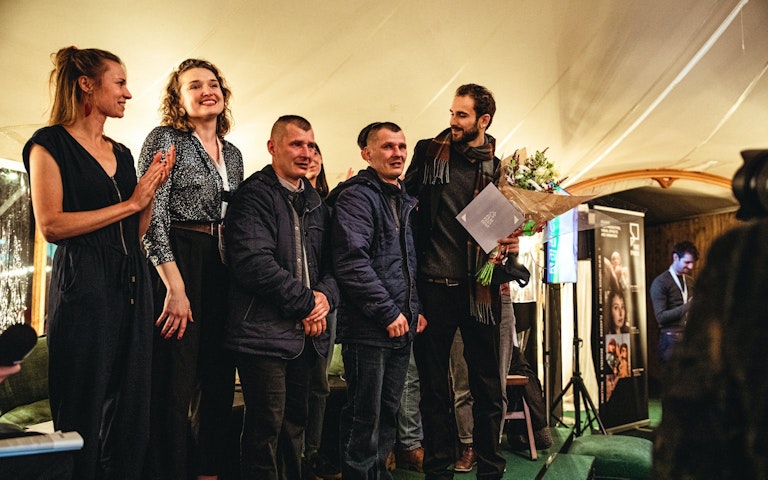Andrea Arnold and Harry Kümel receive the Joseph Plateau Honorary Award

Andrea Arnold
Although Andrea Arnold initially set her sights on an acting career, in the 1990s she swapped her role on the popular children's television programme No. 73 for film school in Los Angeles. In 1998 she made her first short films Milk and Dog. Her third short, Wasp, starring Nathalie Press and Danny Dyer, received an Academy Award in 2003. Her first feature film did not go unnoticed either. The psychological thriller Red Road, which largely follows Lars von Trier and Thomas Vinterberg's Dogme 95 principles, was well-received at the Cannes Film Festival, winning her the Jury Prize. Her second film, Fish Tank (2009), with a young Michael Fassbender on the brink of international fame, won the Jury Prize in Cannes as well. Arnold's adaptation of Wuthering Heights (2011) sidesteps all costume drama clichés and only leaves Brontë's essential ingredients: desire, revenge and the gloomy, inhospitable Yorkshire Moors. Arnold then travelled to the United States, where she made American Honey (2016) with a group of non-professional actors, supported by Shia LaBeouf and Riley Keough. This road movie earned her a third Jury Prize.

"Thanks to Andrea Arnold's films, we get to understand our fellow humans better. Arnold employs the true power of cinema: making the invisible visible."
Andrea Arnold often portrays young people on the fringes of society struggling to escape a suffocating working-class environment. Her poetic cinematography, however, distinguishes her work from the often bleak social-realistic films of the previous generation of compatriots, such as Ken Loach and Alan Clarke. Arnold's predilection for magnetic non-professional actors and her profound understanding of the places she captures on film, lend her work a distinctive authenticity. With her latest film, the documentary Cow, she once again presented the outsider who is being devoured by our capitalist society, this time literally. “Our relationship with the millions of non-human lives we use is very much part of our existence. I made Cow to invite engagement with that,” says Arnold. As one of the most acclaimed British directors of her generation, she is also an inspiration for the next.
 © Johannes De Bruycker
© Johannes De BruyckerHarry Kümel
Harry Kümel made his debut in 1968 with Monsieur Hawarden, in which an Austrian woman on the run ends up in Belgium and assumes the identity of Monsieur Hawarden, based on the novel by Filip De Pillecyn. His next film, the erotic vampire film Daughters of Darkness with the French diva Delphine Seyrig as the Hungarian Countess Elisabeth Bathory, became a worldwide cult hit. The restored version, which was released last year in various cinemas in Belgium and France, also attracted a large audience - 50 years after its original release. In 1971 Kümel recruited none other than Orson Welles for his film adaptation of Malpertuis, the horror story by the Belgian writer Jean Ray. With its opulent decor, the ambitious Malpertuis was selected for the official competition of the Cannes film festival in 1972, alongside Images by Robert Altman and Solaris by Andrei Tarkovsky, among others.
His TV series The Arrival of Joachim Stiller, a time capsule of Antwerp in the 70s and based on the magic-realistic novel by the Antwerp author Hubert Lampo, affirmed his success, this time on the small screen. His most recent film, Eline Vere, was released in 1991, about 100 years after the publication of the novel by Louis Couperus. Ever since the beginning of his career as a director, Harry Kümel has been a much-loved and in-demand film teacher.

"As a stylist, Harry Kümel is hard to beat. He is masterful at sensing and perfectly depicting the boundaries between illusion and reality."
Harry Kümel has been variously described as a provocateur, a living legend, and everything in between. But above all, he is a visionary filmmaker who has never been satisfied with the limits imposed on Flemish film. He put genre film from Belgium on the map internationally, thus making a significant contribution to Belgian film history. His audacity, both thematically and stylistically, paved the way for many Flemish directors working today, and is still being rediscovered by young aspiring filmmakers.
The annual Joseph Plateau Honorary Awards honours guests for their outstanding contribution to the art of filmmaking. The award itself is a replica of Professor Joseph Plateau's Phenakistoscope, a device with which he could “move” a series of successive drawings continuously.
